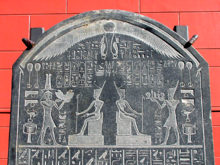lunette
Jump to navigation
Jump to search
See also: lunettes
English[edit]
Etymology[edit]
Unadapted borrowing from French lunette, diminutive of lune (“moon”).
Pronunciation[edit]

Noun[edit]
lunette (plural lunettes)
- (architecture) A small opening in a vaulted roof of a circular or crescent shape. [from 17th c.]
- 1963, Margery Allingham, chapter 14, in The China Governess: A Mystery, London: Chatto & Windus, →OCLC:
- Nanny Broome was looking up at the outer wall. Just under the ceiling there were three lunette windows, heavily barred and blacked out in the normal way by centuries of grime.
- 1982, Lawrence Durrell, Constance (Avignon Quintet), Faber & Faber, published 2004, page 820:
- Next came the semi-landing with the lunette window, and here the door opened under the pressure of a single finger, and with a sigh and creak.
- (architecture) A crescent-shaped recess or void in the space above a window or door. [from 18th c.]

a lunette in the Thomas Jefferson building of the US Library of Congress - 1930, Offner, Steinweg et al., A Critical and Historical Corpus of Florentine Painting, p. 49:
- The decoration of a lunette discovered in the Duomo of Pistoia in the 1950s, which represents Christ blessing and Saints James and John, all bust-length, constitutes a more remarkable and stylistically more advanced approach to painting.
- 1930, Offner, Steinweg et al., A Critical and Historical Corpus of Florentine Painting, p. 49:
- (obsolete) An image or other representation of a crescent moon. [18th–19th c.]
- 1822, Moses Aaron Richardson, The Local Historian's Table Book of Remarkable Occurrences, volume 3, page 245:
- The lesser portions of the tablet has over this Mithras, a lunette or symbol of the moon, who, according to Porphyry's comment, is the queen of generation and as such was denominated by the ancients both a bee and a bull [...].
- (fortifications) A field work consisting of two projecting faces forming a wedge each of which extends from one of two parallel flanks. [from 18th c.]

two kinds of lunette fortification - 1863, Alexander William Kinglake, The Invasion of the Crimea, volume VII, page 185:
- This Lunette, as we have seen, was confronted, and even in siege-form "approached", by a part of Canrobert's army [...].
- 2001, WG Sebald, translated by Anthea Bell, Austerlitz, Penguin, published 2011, page 21:
- In mid-December [...], the French succeeded in storming the half-ruined outwork of the St Laurent lunette and advancing to a position immediately beneath the walls with their breaching batteries.
- (Christianity) A luna: a crescent-shaped receptacle, often glass, for holding the (consecrated) host (the bread of communion) upright when exposed in the monstrance. [from 19th c.]
- 2001, David Philippart, Basket, Basin, Plate, and Cup: Vessels in the Liturgy, page 33:
- On those occasions when lunettes, custodia and monstrances are used, the sacristan needs to be sure that the lunette fits into the given monstrance, that the host fits into the lunette, and that the host is put out before Mass for consecration.
- A type of flattened glass used in watch-making. [from 19th c.]
- 2008, FJ Garrard, Watch Repairing, Cleaning and Adjusting: A Practical Handbook, page 157:
- Lunette and double lunette glasses are generally sized in quarters; crystals and thin flat lunettes for hunters in eighths.
- The circular hole in the guillotine in which the victim's neck is placed. [from 19th c.]
- 1972, Vladimir Nabokov, Transparent Things, McGraw-Hill, published 1972, page 92:
- some "future" events may be likelier than others, O.K., but all are chimeric, and every cause-and-effect sequence is always a hit-and-miss affair, even if the lunette has already closed around your neck, and the cretinous crowd holds its breath.
- (geology) A type of crescent-shaped dune blown up along a lake basin, especially in dry areas of Australia. [from 20th c.]
- 2003, Bill Bryson, A Short History of Nearly Everything, BCA, published 2003, page 403:
- Sticking out of a crescent-shaped sand ridge of a type known as a lunette were some human bones.
- 2006, John K Warren, Evaporites: Sediments, Resources and Hydrocarbons, page 31:
- These lunettes are relicts of a Late Pleistocene deflationary period, when the lacustrine hydrology changed from perennial water-filled lakes to desiccated mudflats.
- (farriery) A half horseshoe, lacking the sponge.
- A piece of felt to cover the eye of a vicious horse.
- An iron shoe at the end of the stock of a gun carriage.
- (in the plural) See lunettes.
Translations[edit]
small opening in a vaulted roof of a circular or crescent shape
crescent-shaped recess or void in the space above a window or door
field work consisting of two projecting faces forming a wedge
|
crescent-shaped dune
Christianity: crescent-shaped clip for holding the host upright
See also[edit]
Anagrams[edit]
French[edit]
Etymology[edit]
Pronunciation[edit]
Noun[edit]
lunette f (plural lunettes)
- (astronomy) telescope (refracting telescope)
- (architecture) lunette
- toilet seat
- (ornithology) breastbone
- (in the plural) eyeglasses, spectacles
Derived terms[edit]
Descendants[edit]
- → Portuguese: luneta
See also[edit]
Further reading[edit]
- “lunette”, in Trésor de la langue française informatisé [Digitized Treasury of the French Language], 2012.
Italian[edit]
Noun[edit]
lunette f pl
Categories:
- English terms borrowed from French
- English unadapted borrowings from French
- English terms derived from French
- English 2-syllable words
- English terms with IPA pronunciation
- English terms with audio links
- Rhymes:English/ɛt
- Rhymes:English/ɛt/2 syllables
- English lemmas
- English nouns
- English countable nouns
- en:Architectural elements
- English terms with quotations
- English terms with obsolete senses
- en:Christianity
- en:Geology
- en:Farriery
- French terms suffixed with -ette
- French 2-syllable words
- French terms with IPA pronunciation
- French terms with audio links
- French terms with homophones
- French lemmas
- French nouns
- French countable nouns
- French feminine nouns
- fr:Astronomy
- fr:Architecture
- fr:Ornithology
- fr:Toilet (room)
- Italian non-lemma forms
- Italian noun forms

